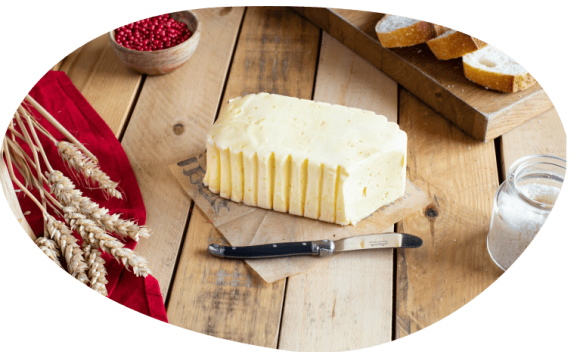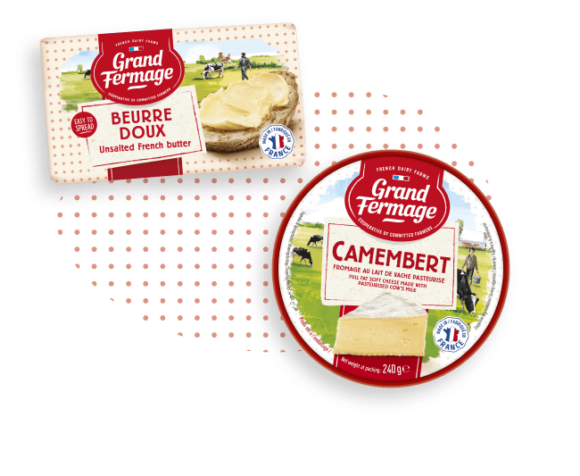Our tips
Discover all our cooking, conservation and health tips for butter, cream and cheese !

Cooking tips
Butter is really the star ingredient of any cookbook! Sauces, cakes… It can be found in numerous recipes.
To make sure everyone’s taste is catered for, it comes in three broad categories:
- unsalted butter which contains very little salt, such as PDO Charentes-Poitou Grand Fermage
- semi-salted butter, which contains between 0.5% and 2% salt, such as semi-salted PDO Charentes-Poitou Grand Fermage
- salted butter, which contains 3% salt, such as Noirmoutier Grand Fermage with sea salt crystals.
You will of course have noticed that the difference between unsalted butter and salted butter is the salt content.
Which aspiring cook has never asked themself this question: how do I know how much butter to put in when I don’t have any scales?
Well – we have two foolproof techniques!
The first: some packets of butter, like Grand Fermage are marked with weighted measures, making it possible to cut off the approximate quantity you need for a recipe.
The second: you can simply refer to the following measures.
- 1 tea spoon is equivalent to 5g of melted butter
- 1 soup spoon is equivalent to 15g of melted butter
In actual fact, there are three ways to melt butter: over a bain-marie, in the microwave, or in a saucepan.
Melting butter over a bain-marie:
This technique allows the butter to melt gently at a low temperature. All you need to do is fill a big saucepan with water and put it on the heat. When the water in the saucepan is hot, put another, smaller receptacle containing chopped butter over the top of the pan. Don’t forget to stir it regularly to get a smooth, homogenously melted butter
Melting butter in the microwave:
Using a microwave is a very quick way of melting butter. Be careful not to leave it in there for too long, otherwise it may burn.
Melting butter in a saucepan:
It is also possible to melt butter in a saucepan. To do this, cut the butter into pieces and melt it on a low heat without stirring. Be careful not to heat it too much, otherwise it may burn.
To start with; what is clarified butter?
It’s butter that has first been melted, then had its proteins extracted: casein and whey protein. Its main advantage is that it can stand higher temperatures and therefore won’t darken when you melt it in the pan. Practical!
So; here is how to make this famous butter:
- Cut the butter into pieces and melt it in a thick-bottomed pan on a low heat without stirring.
- When the butter has completely melted, turn off the heat, and using a skimmer or a spoon, lift off the white mousse which has risen to the surface.
- Now tip the yellow liquid which is left into a jar, let it cool and then put it in the fridge.
You will now be able to use this clarified butter in your recipes. It will give all your meals a delicious buttery taste.
Softened butter, or ‘beurre pommade’, is a basic recipe in any recipe book! But how is it made?
1. Cut the butter into pieces and leave it at room temperature for half an hour to let it soften.
2. Once the butter has softened, put it into a bowl and work it with a whisk until it forms a soft texture with a smooth, flexible consistency.
You will find softened butter in numerous recipes such as butter icing, crêpes Suzette, mousseline cream…
Browned butter is a butter which his heated to a high temperature without burning. Follow this recipe to make it:
- Cut the butter into pieces and melt it in a thick-bottomed pan on a low heat.
- Once the butter has melted, it will begin to froth gently.
- Mix it with a wooden spoon until it has browned and has a nutty odour.
- Once you have made the browned butter, quickly pour it into a cold receptacle to stop it cooking.
This browned butter is ideal for pastry recipes for things like madeleines, financiers and pancakes, but also for topping a delicious skate wing!
If you like cooking with butter, you will probably have already noticed the phenomenon that when you melt butter in a very hot pan, it has a tendency to darken.
But – did you know that darkened butter, as well as tasting different, is strongly advised against being part of a healthy diet?
To resolve this problem, simply add a few drops of sunflower oil to the pan. You can also make clarified butter, which will not burn when you heat it in the pan.
Don’t doubt it – cooking with butter is what we’re all about at Grand Fermage. But which butter is best for cooking?
To sauté onions or vegetables, you can use:
–PDO Charentes-Poitou butter
-biological butter
-moulds from the Vendée
Unsalted or semi-salted, you decide. Just remember to add a touch of salt if you prefer cooking with unsalted butter.
A little piece of advice; be careful when cooking butter! If it is heated too quickly to too high a temperature, it may burn… this may then alter the taste and it’s not advisable for a healthy diet.
Unsalted PDO Charentes-Poitou is very highly regarded by top pastry chefs for making delicious Viennese pastries and desserts! Indeed, one of its features is that it melts more slowly than other butters.
It will ensure that all your pastries are beautifully flaky, light and soft!
Light, crusty, with a strong buttery taste, puff pastry is ideal for fruit, vegetable and cheese tart recipes.
To make a tasty puff pastry, unsalted PDO butter Charentes-Poitou comes highly recommended by great pastry chefs. Indeed, it melts more slowly than other butters because of its higher level of fatty acids.
It could even be said that unsalted PDO Charentes-Poitou is the king of puff pastry!
To make a delicious Galette des Rois, a high quality butter is essential.
Just like when you are making puff pastry, use an unsalted butter such as PDO Charentes-Poitou to get an excellent buttery-tasting pastry!
Butter is an essential ingredient in the making of shortbread!
As it’s in the majority of recipes, there are not many rules to follow on the use of any particular type of butter.
You can, therefore, choose a salted GF which will provide a hint of salt and bring out the flavours of the recipe. Or indeed you may prefer unsalted GF , but don’t forget to add a pinch of salt to bring out the flavours of the various ingredients.
To create a springy, squidgy and flavoursome brioche, use unsalted butter, which will bring an excellent buttery taste to the recipe.
For breakfast or for a cheeky snack, try the brioche you’ve made spread with a little knob of butter. A meal fit for royalty.
To make pancake batter, there are two schools of thought: there are those who use oil to avoid the pancakes sticking to the pan, and there are the Bretons, who use butter!
At Grand Fermage, we think pancakes made with butter actually have a slightly better taste!
In a recipe to make waffle batter, there are two camps; one which uses oil to avoid the waffles sticking to their waffle irons, and the other, the butter fans.
At Grand Fermage, we’re more in the buttery waffle camp… we find they taste better!
In the numerous recipes that exist for cake baking, there are no real rules to follow on the type of butter to use.
You can use:
- Grand Fermage salted butter, which will provide the recipe with a touch of salt and will bring out the flavours of the ingredients, or you may prefer
- Grand Fermage unsalted butter , in which case don’t forget to add a pinch of salt to give extra taste to the recipe.
Unless otherwise stated in the recipe, the type of butter you use in a bechamel isn’t too important.
Ideally, use an unsalted butter like PDO Charentes-Poitou, a semi-salted biological butter, or even a salted butter.
The final, most important thing is to get the right quantity. For example, to make 75cl of bechamel, you will need:
- 75 g butter,
- 75 g flour,
- 75cl of cold milk.
Is there a secret to a successful bechamel? Stay right next to it on the heat and stir it constantly! This will ensure you make a smooth, unctuous bechamel.
For a truly sumptuous flavour experience, serve your plate of oysters with sea-salted butter like Noirmoutier Grand Fermage.
The little grains of salt cracking in the butter and its lightly iodised taste marry perfectly with these shellfish!
For New Year’s Eve parties, salmon toasts are always on the menu; they’re generally a great crowd pleaser!
Here is an exclusive look at our secret recipe for delicious smoked salmon toasts:
- Lightly toast your bread; it can be seeded, be crispbread, or even blinis.
- Spread the toast with unsalted biological GF, because the salmon is already very salty.
- Add a squeeze of lemon to the canopé and taste it!
For a slightly more elaborate recipe; link to the smoked salmon toast recipe.
To make butter icing, nothing beats unsalted butter.
But be careful – it mustn’t be melted, only softened.
Once it’s nicely softened, all you need to do is whisk it until you have a smooth, unctuous cream.
Cooking just isn’t quite right without a bit of fat! But how do you choose between butter and oil, the two most popular fats in France?! The debate is on!
There is an invisible line separating the north and south of France.
The regions to the north of the Loire cook primarily with butter, while the regions south of the Loire cook mainly with oil, in particular olive oil.
At Grand Fermage, we are firmly in camp butter, so you’re probably right in thinking that our minds are made up!
Butter melted in a pan can darken if it is heated for too long.
Indeed, butter doesn’t do well under cooking temperatures, as when it is cooked too quickly and at too high a temperature, it burns. This change is called the Maillard reaction (a chemical chain reaction which take place during the process of cooking ingredients).
It’s quite simple; you can put butter into the pan as soon as the pan begins to heat up.
However, do take care – butter that is heated to too high a temperature does tend to burn; this is something which changes its taste and is not recommended as part of healthy diet.
There is nothing easier to cook than pasta or rice with butter!
1. Cook the pasta or rice in boiling water until it is tender.
2. Once your pasta or rice is cooked and still warm, add a knob of butter and mix in well.
That’s all you need to do! All that remains is to eat it.
A mix of garlic and parsley, butter for snails is also called garlic butter. Do you want to learn how to make a delicious garlic butter for snails? Simply follow this recipe:
- Cut the butter into pieces and leave it at room temperature for half an hour to let it soften.
- Chop the shallot, garlic and parsley in to a bowl, then add pepper.
- Add the softened butter and mix it all together to form a smooth cream.
Easy to make, this garlic butter for snails will bring all your recipes up to the next level!
Have you ever wondered about how to turn butter in to a mousse? Well you’re in right place!
- Cut the butter into pieces and leave it at room temperature for half an hour to let it soften.
- Once the butter has softened, whisk it with a fork, a whisk, or a mixer until you achieve a mousse-like texture. This stage of the recipe will require a little patience – it will take a while to whisk the butter into a mousse.
Are you still racking your brains as to how to choose a good GRAND FERMAGE Camembert?
Don’t panic – here is some of our special Grand Fermage know-how!
- The first important thing is to look at the rind of the Camembert. It should be nice and smooth, not hollow or cracked. The smoother and whiter the rind is, the tastier the product will be. The more wrinkled and yellow the rind is, the blander the product will taste.
- The heart of the Camembert is the next thing to check; it should be neither too runny nor too firm.
So there you have it, simple!
You have everything you need to select the ideal Camembert!
Remove the Camembert from its box and paper. Cover the Camembert with tin foil and place it directly on the hot embers of the barbecue.
Leave to cook for 15-20 minutes.
If you’d like to, add thyme, sun-dried tomatoes, honey and rosemary before cooking…
Take the Camembert out of its packaging.
Place your Camembert in a ramekin, and place in the oven for around 15 minutes.
Before cooking, you can if you wish make a cross in the rind on top of the Camembert, into which you can insert cooked lardons and a few lightly browned onions.
Serve with a salad and hot potatoes.
First of all, make sure that the Camembert is well-cooked all the way through by pricking it with the blade of a knife.
If the blade enters easily, pop some gloves on or use an oven-cloth to remove the Camembert from the embers, because it is ready!
Remove part of the rind by making a cross in the centre of the cheese.
Put it in the centre of the table and eat it! Dip in breadsticks, hunks of bread, bits of potato, crisps…
Put your bowl and whisk in the fridge for an hour.
When your utensils are nice and cold, whisk your cream. This will give it a more unctuous, more airy texture.
In order to make the perfect butter croissant, the first step is kneading the dough…without adding butter. Weird, right? Let us explain. To start you should knead all the ingredients together vigorously along with ice cold water, using a stand mixer with a dough hook. That is, all the ingredients except the dry butter, which will be carefully introduced during the next step. Then leave the dough to rest in the fridge.
The second step (adding in the butter) is a little more technical. To do this right, you’ll need your butter to be ever-so-slightly soft – just enough so that when you press on it you can see your fingerprint. To get it soft, beat the butter into a flat rectangle with a rolling pin. Make sure you keep the rolling pin nice and flat when it hits the butter so you get a smooth, even surface. Once the butter is softened, put it back in the fridge to chill briefly before adding into the mixture (you’ll be doing this in three steps).
NB: between each step, remember to put your dough back in the fridge to cool for about half an hour, wrapping in cling film so it doesn’t dry out.
If everything has worked out right, you’ll be able to roll out a sheet of dough around 20cm across and 1cm thick. All you have to do now is cut it in two, then into triangles around 12cm along their edges. Roll these up carefully to make your croissants.
To ensure they bake perfectly, place the edges of your croissants in direct contact with the oven tray. And there you have it!
So, do you prefer your pastry dough sablée (‘sandy’) or crémée (‘creamed’)? We’ve all heard these fancy French terms for making dough, but which one is best for your recipe? Well, it all depends! For sweet doughs and sweet shortcrust pastry, the cremage method is preferred. By contrast, when making tart shells or pie crusts, we’d go for the sablage method.
So, let’s talk technique.
When using the cremage method, the butter and sugar are creamed together (hence the name), then beaten until crumbly and added to the pre-mixed ingredients. The flour is then added in to the mixture obtained, which is then kneaded while adding water or milk as required. You then press and roll the dough with the palm of your hand before rolling it into a ball. The whole thing is wrapped in cling film, then placed in the fridge and left to cool for 30 minutes before using.
With the sablage method, we start by dissolving the salt and sugar in a little water, before adding the butter in small cubes. We then rub in the butter with our fingertips to obtain a sandy texture, into which we can then add the necessary amount of water, or possibly an egg. Then we mix this with the scraper and bring everything together, kneading with both hands. To finish, press and roll the dough with the palm of your hand and form into a ball. All that’s left is to cover it with cling film and store in the fridge.
Pastry enthusiasts take note!
Did you know that in order to make a croissant with its characteristic puffy shape, you need to fold your dough in on itself? This folding is what gives us the pastry its puff, and it’s a crucial step! There are even two different techniques to try: single turn and double turn (sometimes known as book folding and wallet folding).
As the name indicates, the first method involves folding the dough over the butter once and then rolling it out – this is known as a “turn.” The second, as you might have guessed, involves making a double turn, i.e. a single turn folded over on itself. It stands to reason that this method can help you save time. Rest assured though: whichever method you use, the result should turn out the same!
In about 30 seconds you’ll be the undisputed champion of making quenelles!
Start by opening up a pot of well-chilled full-fat creme fraiche, then take two well-rounded dessert spoons and dunk them in hot water. Pro tip: use silver spoons if you can: they conduct heat better and won’t cool down as quickly.
Take a big scoop of cream in the first spoon, then smooth out the back of the spoonful using the second spoon, lifting it and scooping into this second spoon. How’d you do?
To finish, put the first spoon back into the warm water and repeat the motion to smooth out the final side.
Pro tip: the faster your movements, the better the quenelle will turn out.
Now all that remains is to place your beautiful quenelle on top of (or alongside) the dessert. And there you have it!
Are you looking to get the perfect golden colour and irresistible crunch on your Grand Fermage camembert bites? Follow our guide!
– For deeper browning, pre-heat the oven to 200°C/400°F. Then set your breaded camembert bites on a grill rack lined with parchment paper, and bake for 10 minutes.
– For faster cooking times, use a frying pan: fry for 8 minutes on medium heat, turning regularly.
– For an even crunchier (and healthier) result, use an Airfryer and cook for 1 minute 30 seconds. At Grand Fermage, this method is our favourite!
Dig in while they’re hot!
Camembert is something of a star among cheeses. It’s highly versatile, and can be enjoyed in sandwiches or wraps, on bruschetta or pizza, served on a cheese board, in a savoury muffin, and even smoked on the barbecue! That said, in its home country of France the proud camembert is traditionally eaten as part of a cheese board, served at room temperature and cut into portions to be paired with fresh baguette. Sometimes it might be served with walnuts or fruit (apples, pear, apricot, fresh figs, grapes, etc.), or even with honey or jam.

Conservation tips
Butter is very sensitive to the oxygen in the air. Opened and badly kept, it can sometimes go rancid and take on a strong odour and a pungent flavour. How can I resolve this?
Our tip for this is to stick a carrot into the middle of the butter (cleaned and peeled beforehand) for several hours.
And, as if by magic, your butter will lose its pungent taste and will no longer be rancid!
So that your butter doesn’t go rancid in the first place, remember to put it in the fridge after use.
To limit the potential for it going rancid, you can also, as well as wrapping in its original cover, cover it with aluminium foil.
So that your butter keeps well, store it in the fridge at between +2 and +8°C.
Some people like butter to be spreadable, and for this reason keep it at room temperature, whereas others prefer to keep it in the fridge. So is there a rule?
Optimal butter storage is generally recommended to be at between +2 and +8°C, in the fridge.
As butter is a sensitive material, if yo wish to leave it at room temperature, it is advised to remove the amount you want to use and place it in a covered butter dish for one or two hours.
It’s not easy to keep butter in the fridge without it taking on the smell of other food! So what can I do?
It is advised to store cheese in the fridge, but should they be at the top or the bottom!
It’s advised that the best type of storage for cheese is not in direct contact with the air from the fridge.
It is therefore preferable to keep it in the vegetable compartment (the least cold area of the fridge) or in a cheese box positioned on the lowest shelf of your fridge.
Whether it’s light or full-fat, all creme fraiche has an expiration date and should be stored in the fridge (4°C). However, once the pot is opened it should not be stored for any longer than 48 hours. Any longer than that and the flavour will start to spoil.
With its soft, supple texture, pale interior and velvety white crust, who doesn’t love a bit of our famous camembert, the iconic French cheese with its exquisite flavour? Nobody, that’s who. Even so, there are plenty who might not know what the best way to store this cheese is. Let’s get into it.
For starters, camembert will keep better and longer if stored in the refrigerator. If unopened, it can be kept up until its expiry date. However, once it’s opened you should consume it within a few days. A good tip to prolong its shelf life (and avoid stinking up your whole fridge) is to put your precious cheese under a glass ‘cloche’ bell jar.

Health tips
Raw butter is made from cream that has not been subject to a thermal sanitisation treatment.
Pasteurised butter is made from cream that has been pasteurised, which involves heating to 90° for a few seconds to eliminate any pathogens.
For children between 0 and 10 years, pregnant women and elderly people, ANAES (the French Agency for Food, Environmental and Occupational Health Safety) recommends avoiding raw milks and butters because of the risk of food infections.
There is no way you can make a mistake with us since all Grand Fermage butters are made from pasteurised milk!
Butter is naturally gluten-free, it features on the list of foods suitable for people with gluten intolerances.
Traditional butter contains between 80% and 90% fat, obtained from milk.
Indeed, traditional margarine also contains between 80% and 90% fat, from vegetable oils.
Butter and margarine provide approximately the same amount of calories.
But of course, at Grand Fermage, we prefer the great taste of butter!
The fat levels in traditional butter are between 80% and 90%, whereas in fresh cream this figure is less than 30%. The caloric intake from butter (730 kcal for 100g*) is thus greater than that from fresh cream (295 kcal for 100g*).
It is important to stress that as the fat content decreases, so does the vitamin content.
Butter is a key source of vitamin A which plays a role in vision, growth, and immunity; and of vitamin D which is needed for calcium fixation.
Thus, it is important to keep eating buttered toast for breakfast, or adding a knob of butter to enhance the flavour of your vegetables, at recommended doses.
* Anses – Table of the nutritional composition of foods Ciqual 2017
Indulgent and flavourful, creme fraiche is the lightest and least calorie-dense of all dairy fats. Obtained during the skimming process, it contains just 32g of fat per 100g ! This is quite low, especially when compared to oil, butter or margarine. So if you’re on a diet, why not try it out? Quiches, soups, ground meat, salmon, carbonara, spinach, pizza, tarts and desserts of all kinds: creme fraiche pairs beautifully with all sorts of recipes and sauces – try it for yourself, you won’t look back!

Can't find the answer to your question?
Contact usTo go further ...
Our cooperative is run by our breeders!
A french cooperative
Our Grand Fermage breeders promote the biodiversity!
Our CSR approach!



